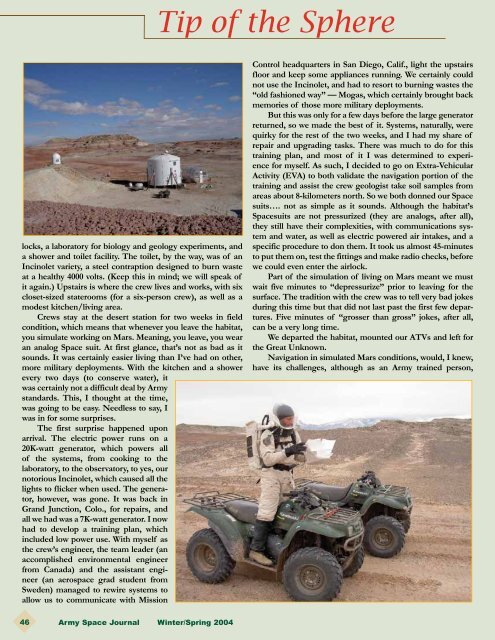Volume 3, Number 1 - Space and Missile Defense Command - U.S. ...
Volume 3, Number 1 - Space and Missile Defense Command - U.S. ...
Volume 3, Number 1 - Space and Missile Defense Command - U.S. ...
You also want an ePaper? Increase the reach of your titles
YUMPU automatically turns print PDFs into web optimized ePapers that Google loves.
Tip of the Sphere<br />
locks, a laboratory for biology <strong>and</strong> geology experiments, <strong>and</strong><br />
a shower <strong>and</strong> toilet facility. The toilet, by the way, was of an<br />
Incinolet variety, a steel contraption designed to burn waste<br />
at a healthy 4000 volts. (Keep this in mind; we will speak of<br />
it again.) Upstairs is where the crew lives <strong>and</strong> works, with six<br />
closet-sized staterooms (for a six-person crew), as well as a<br />
modest kitchen/living area.<br />
Crews stay at the desert station for two weeks in field<br />
condition, which means that whenever you leave the habitat,<br />
you simulate working on Mars. Meaning, you leave, you wear<br />
an analog <strong>Space</strong> suit. At first glance, that’s not as bad as it<br />
sounds. It was certainly easier living than I’ve had on other,<br />
more military deployments. With the kitchen <strong>and</strong> a shower<br />
every two days (to conserve water), it<br />
was certainly not a difficult deal by Army<br />
st<strong>and</strong>ards. This, I thought at the time,<br />
was going to be easy. Needless to say, I<br />
was in for some surprises.<br />
The first surprise happened upon<br />
arrival. The electric power runs on a<br />
20K-watt generator, which powers all<br />
of the systems, from cooking to the<br />
laboratory, to the observatory, to yes, our<br />
notorious Incinolet, which caused all the<br />
lights to flicker when used. The generator,<br />
however, was gone. It was back in<br />
Gr<strong>and</strong> Junction, Colo., for repairs, <strong>and</strong><br />
all we had was a 7K-watt generator. I now<br />
had to develop a training plan, which<br />
included low power use. With myself as<br />
the crew’s engineer, the team leader (an<br />
accomplished environmental engineer<br />
from Canada) <strong>and</strong> the assistant engineer<br />
(an aerospace grad student from<br />
Sweden) managed to rewire systems to<br />
allow us to communicate with Mission<br />
Control headquarters in San Diego, Calif., light the upstairs<br />
floor <strong>and</strong> keep some appliances running. We certainly could<br />
not use the Incinolet, <strong>and</strong> had to resort to burning wastes the<br />
“old fashioned way” — Mogas, which certainly brought back<br />
memories of those more military deployments.<br />
But this was only for a few days before the large generator<br />
returned, so we made the best of it. Systems, naturally, were<br />
quirky for the rest of the two weeks, <strong>and</strong> I had my share of<br />
repair <strong>and</strong> upgrading tasks. There was much to do for this<br />
training plan, <strong>and</strong> most of it I was determined to experience<br />
for myself. As such, I decided to go on Extra-Vehicular<br />
Activity (EVA) to both validate the navigation portion of the<br />
training <strong>and</strong> assist the crew geologist take soil samples from<br />
areas about 8-kilometers north. So we both donned our <strong>Space</strong><br />
suits…. not as simple as it sounds. Although the habitat’s<br />
<strong>Space</strong>suits are not pressurized (they are analogs, after all),<br />
they still have their complexities, with communications system<br />
<strong>and</strong> water, as well as electric powered air intakes, <strong>and</strong> a<br />
specific procedure to don them. It took us almost 45-minutes<br />
to put them on, test the fittings <strong>and</strong> make radio checks, before<br />
we could even enter the airlock.<br />
Part of the simulation of living on Mars meant we must<br />
wait five minutes to “depressurize” prior to leaving for the<br />
surface. The tradition with the crew was to tell very bad jokes<br />
during this time but that did not last past the first few departures.<br />
Five minutes of “grosser than gross” jokes, after all,<br />
can be a very long time.<br />
We departed the habitat, mounted our ATVs <strong>and</strong> left for<br />
the Great Unknown.<br />
Navigation in simulated Mars conditions, would, I knew,<br />
have its challenges, although as an Army trained person,<br />
46<br />
Army <strong>Space</strong> Journal Winter/Spring 2004

















